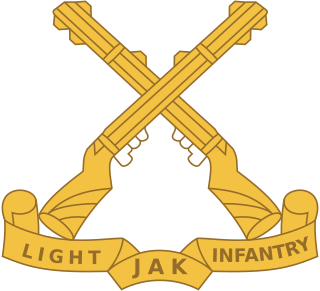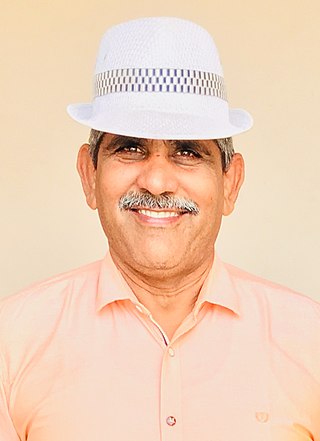
The 4th Indian Infantry Division, also known as the Red Eagle Division, is an infantry division of the Indian Army. This division of the British Indian Army was formed in Egypt in 1939 during the Second World War. During the Second World War, it took part in campaigns in East Africa, Syria, North Africa and Italy. Post independence, the division is part of the I Corps and headquartered at Prayagraj.
The 1st Armoured Division is an armoured division of the Indian Army, headquartered at Patiala, Punjab. It is part of II Corps of the Indian Army's Western Command.

Indian Peace Keeping Force (IPKF) was the Indian military contingent performing a peacekeeping operation in Sri Lanka between 1987 and 1990. It was formed under the mandate of the 1987 Indo-Sri Lankan Accord that aimed to end the Sri Lankan Civil War between Sri Lankan Tamil militant groups such as the Liberation Tigers of Tamil Eelam (LTTE) and the Sri Lankan military.

The Jammu and Kashmir Light Infantry is an infantry regiment of the Indian Army. The regimental center is in Srinagar's Airport Complex at Awantipora with a winter setup near Jammu. Its regimental insignia consists of a pair of crossed rifles. The regiment mostly consists of volunteers from the state of Jammu & Kashmir and ethnic groups from the state. The Jammu and Kashmir Light Infantry is considered to be one of the most decorated regiment of the Indian army having won 1 Param Veer Chakra and 3 Ashok Chakra. Naib Subedar Chuni Lal of the 8th battalion Jammu and Kashmir Light Infantry is one of the most decorated personnel of the Indian Army.
The Sikh Light Infantry is a light infantry regiment of the Indian Army. The regiment is the successor unit to the 23rd, 32nd and 34th Royal Sikh Pioneers of the British Indian Army. The regiment recruits from the Sikh community of Himachal Pradesh, Punjab and Haryana states of India. The versatility of the Sikh Light Infantry has seen the regiment conduct operations from conventional warfare on the Siachen Glacier, the highest battlefield in the world, to counter-terrorism. Units of the regiment have also been deployed as part of the United Nations Emergency Force. The regimental motto is "Deg Tegh Fateh", meaning "prosperity in peace and victory in war". The motto has great significance with the tenth Sikh guru, Guru Gobind Singh, with whom the Mazhabi community is very closely associated, Guru Gobind Singh named them mazhabhi as in faithful for their dedication to do good. The regiment's cap badge is a chakram or quoit, with a mounted kirpan. The insignia was designed to honour the Mazhabi community's Akali Nihang ancestry.

Major Ramaswamy Parameswaran, PVC, Parry to his colleagues, was an Officer of the Indian Army who was awarded the Param Vir Chakra, India's highest military decoration, for his bravery.
The Jaffna University Helidrop was the first of the operations launched by the Indian Peace Keeping Forces (IPKF) aimed at disarming the Liberation Tigers of Tamil Eelam (LTTE) by force and capturing the town of Jaffna, Sri Lanka, in the opening stages of Operation Pawan during the active Indian mediation in the Sri Lankan Civil War. Mounted on the midnight of 12 October 1987, the operation was planned as a fast heliborne assault involving Mi-8's of the No.109 HU, the 10th Para Commandos and a contingent of the 13th Sikh LI. The aim of the operation was to capture the LTTE leadership at Jaffna University building which served as the Tactical Headquarters of the LTTE, which was expected to shorten Operation Pawan, the battle for Jaffna. However, the operation ended disastrously, failing to capture its objectives due to intelligence and planning failures. The helidropped force suffered significant casualties, with nearly the entire Sikh LI detachment of twenty-nine troops, along with six paracommandos, falling in battle.
The 11th Indian Infantry Division was an infantry division of the Indian Army during World War II. It formed part of Indian III Corps in the Malaya Command during the Battle of Malaya. The division was re-raised on 1 April 1965 and is presently part of the XII Corps of Southern Command. It is presently responsible for safeguarding the borders with Pakistan along Southern Rajasthan and Gujarat.
""Operation Pawan- The Battle for Jaffna"".

Brigadier Kuldip Singh Chandpuri MVC, VSM was a decorated Indian Army officer. He is known for his leadership in the Battle of Longewala during the Indo-Pakistani War of 1971, for which he was awarded the Maha Vir Chakra, the second highest Indian military decoration, by the Indian government. The 1997 Hindi film Border was based on the battle, with his role played by Sunny Deol. He was a councillor in the Chandigarh Municipal Corporation from 2006 to 2011.
Padhiana is a village in the tehsil and district of Jalandhar, Punjab, India. It falls in Adampur block of the district. The village has 794 hectares of land. The population of Padhiana was 2885 at the 1991 census.

Digendra Kumar MVC, SM is a former soldier of the 2nd battalion of the Rajputana Rifles regiment of the Indian army. He was awarded the Mahavir Chakra on 15 August 1999, for his acts of bravery in the Kargil War. He retired from the army on 31 July 2005.
Lieutenant General Khem Karan Singh MVC was a General Officer in the Indian Army. He was awarded Padma Bhushan for his services to the nation during the 1971 war. He also received Maha Vir Chakra for his services during 1965 Indo-Pakistan war.
65th Armoured Regiment, is an armoured regiment which is part of the Armoured Corps of the Indian Army.
Lieutenant-General Joginder Singh Gharaya MVC, KC, VSM was a highly decorated Indian Army general and the only member of the Indian Armed Forces to have won both the Maha Vir Chakra and the Kirti Chakra, the second highest wartime and peacetime Indian decorations.

The 54th Infantry Division is an Infantry division of the Indian Army. The Division was raised as an Infantry Division, but was converted into a Reorganised Amphibious Formation (RAMFOR) in 2011. It is currently the only division of the Indian Army which carries out Amphibious warfare. The division is headquartered at Secunderabad in Telangana and is a part of XXI Corps. The Division is commanded by a Two-star General Officer of the rank of Major General titled General Officer Commanding (GOC).
Commodore Arvind Singh, MVC, NM was an officer in the Indian Navy notable for his participation in Operation Pawan, in Sri Lanka as part of the Indian Peace Keeping Force. He displayed exemplary courage and leadership during the conflict. He was awarded the Maha Vir Chakra, India's second highest military decoration and the Nau Sena Medal for gallantry and leadership in different operations.
Brigadier Kailash Prasad Pande, MVC was an officer in the Indian Army, who served with the Regiment of Artillery. He was awarded the Maha Vir Chakra, India's second highest award for his role in the Indo-Pakistani War of 1971.

Brigadier Narinder Singh Sandhu MVC was an Indian Army officer who was awarded the Maha Vir Chakra (MVC), the second-highest Indian military decoration, for gallantry, leadership and devotion to duty during the Indo-Pakistan War of 1971. Sandhu was commissioned into the Indian Army Armoured Corps in 1953, and participated in the Battle of Asal Uttar during the Indo-Pakistani War of 1965, and was mentioned in dispatches. He transferred to the Dogra Regiment in 1970, and it was for his performance as commanding officer of the 10th Battalion, Dogra Regiment during an assault on a fortified Pakistan Army position that he was awarded the MVC. He retired as a brigadier and was active in veterans' and gallantry award recipients' matters until his death of colorectal cancer in 2018.
Major General Dalvir Singh AVSM, VrC, VSM is a retired Indian Special Forces officer, a former General Officer of the Indian Army and the recipient of Vir Chakra, India's third-highest War-time gallantry award. He has commanded the 10th Battalion Special Forces, the elite 52 Special Action Group of the NSG, Kilo Force of the Rashtriya Rifles and the Territorial Army (India), with distinction. After retirement from active military service, he has been serving as the Director Training of Rajasthan Police Training Center Jodhpur.







